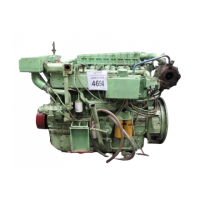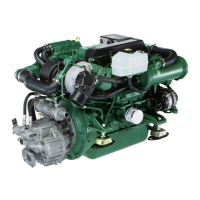16
Fuel, Oils, Coolant
Diesel fuels
The composition of the fuel is vital for operation of the
engine, its service life, and emissions. To meet the per-
formance specified and to run your boat cleanly and
quietly, it is vital that you use fuel as recommended be-
low:
Fuel specifications
The fuel must be approved according to national and in-
ternational standards for commercial fuels, for example:
– EN 590 (With environmental and sub-zero tempera-
ture specifications according to national require-
ments)
– ASTM-D 975 No. 1-D and 2-D
– JIS KK 2204
Sulfur content: According to current legislation in the
respective country.
Use of fuel with an extremely low sulfur content (Urban
Diesel fuel in Sweden and City Diesel in Finland) can
result in a reduction in output of approx. 5% and in-
crease in fuel consumption of approx. 2–3%.
Lubricating oil, engine
A lubricating oil of a grade in accordance with the table
below should be used:
Designation Standard
VDS* VDS* Volvo Drain Specification
CD,CE API (American Petroleum
Institute)
MIL-L-2104D US Government Military Spec.
* A VDS oil must be used if there is to be a long period be-
tween oil changes. See also the maintenance schedule and
“Technical Data”.
We do not advise that you run on an oil of a grade
which does not meet the above requirements. This is a
poor solution with respect to both economy and operat-
ing safety.
For viscosity and capacities, see “Technical Data” on
page 74.
Lubricating oil, reverse gear
For the reverse gear, a single grade oil of grade CC, CD
or CE according to the API system should be used. Oil
according to the MIL-L-2104D standard may also be
used.
For viscosity and capacities, see “Technical Data” on
page 76.
Oil for servo unit system, hydraulic
pump
(accessory)
ATF oil* should be used in the servo unit system.
* ATF = Automatic Transmission Fluid (oil for automatic gear-
boxes).
Coolant
The engine’s internal cooling system (freshwater sys-
tem) is filled with a mixture of freshwater and additives.
NOTE! Never use freshwater without additives. The fol-
lowing recommendations should be followed to prevent
frost and corrosion damage to your engine:
When there is a chance of freezing
Use a mixture of 50% Volvo Penta antifreeze (glycol)
and 50% pure water (as neutral as possible). This mix-
ture will protect against freezing to a temperature of
approx. –40°C (–40°F) and should be used all year
round.
Note. There should be at least 40% antifreeze in the
system for complete protection against corrosion.
NOTE! Glycol is harmful to health (dangerous
if ingested).
When there is no chance of freezing
When there is no risk of freezing the engine coolant
mixture additive is Volvo Penta anti-corrosion agent* (P/
N 1141526-2) which must be used unless an antifreeze
mixture is used all year round. Mixture ratio = 1:30.
See instructions on page 55 for topping up engine cool-
ant. Run the engine once the coolant has been topped
up to allow the additives to work.
NOTE! Anti-corrosive agents are harmful to
health (danger if ingested).
* Note Never mix antifreeze (glycol) and anti-corrosive agents.
The two combined can produce foam and drastically reduce
the coolant’s effectiveness.
Replacing the coolant
The coolant should be replaced and the system flushed
at least once every second year. See maintenance
schedule.
Volvo Penta products
See also under the heading See also under the head-
ings “Accessories” on page 78.

